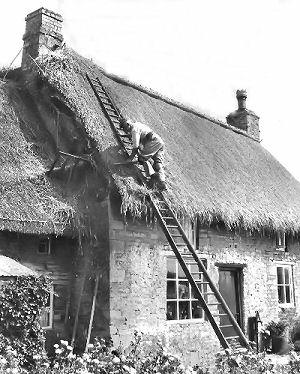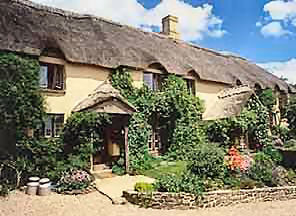

|
Witheridge, along with the rest of Devon, has been using Thatch for roofing for more than 600 years, and it has survived better in Devon far better than in other parts of the country. It has become a major part of the identity and character of Devon, and the picturesque thatched cottages found in so many of our villages are a lasting memory for many visitors to the region. Thatching is one of the oldest building crafts, and little changed since the Middle Ages, and there is evidence to suggest that the use of thatch for roofing goes back as far as the Bronze Age in Britain. The use of thatch originated from ancient building practices, which made use of lightweight, irregular materials, such as wattle and daub walls, and cruck beams. These walls could not take much weight, and thatch was by far the lightest weight material available. The materials used in thatch buildings can get obscure, but people used whatever was available locally, including; broom, sedge, sallow, flax, grass, and straw. Most common is wheat straw in the south of England, and reeds in East Anglia. Thatching itself is a highly skilled job and the materials most commonly used are long straw, combed wheat reed and water reed. The first two being farm crops, both obtained from the cereal plant wheat. The basic technique for laying the roof involves first tying the thatch into bundles, and then laying an under-layer on the roof beams. These are pegged in place using rods made from 'hazel or withy' A second or upper layer follows on top of the under layer, and a final reinforcing layer added along the ridgeline. Some thatchers will often leave a personal "signature" in the form of a decorative feature of some kind that marks the job as his alone. A typical life span for a well-thatched roof can be as much as 70 years. They are highly energy efficient, providing excellent insulation and keeping houses warm in winter and cool in summer. Damp does not penetrate far into the top layer of a thatched roof in good condition, and the deep projecting eaves removes the need for guttering.
On a traditional Devon combed wheat reed roof, the straw is sorted or "combed", so that only the butts are visible on the surface of the roof and the straw is laid at such an angle so that only a very small length of the straw is exposed on the surface. This method of thatching was traditional in Devon and hence referred to as "Devon Reed". Combed wheat reed is prepared for thatching by feeding handfuls of wheat straws into the conveyor belts that lead up to the combing machine, an attachment to an ordinary threshing machine. In here the straws will be combed free of grain, leaves and any debris present without actually entering the threshing drum where damage to the stalks could occur. Once combed, the wheat reed leaves the machine and is tied into bundles, all butt ends lying the same way. The combing process allows the thatcher to work with this material in virtually the same, as he would do if using water reed. A thatch of combed wheat reed would normally last for between thirty to forty years. Thatchers working with combed wheat reed occasionally use a shearing hook to trim the surface of the thatch in order to obtain a neater finish to the completed roof. A thatch of water reed would normally last for between fifty to one hundred years. After fastening each layer of either water reed or combed wheat reed to the roof, the exposed ends of the material are beaten upwards using a leggett, a tool, usually made of wood and specific to reed thatching. This is in direct contrast to long straw thatching, where the material is combed in a downwards direction. The beating action pushes the reeds further back and under the ties that secure them to the roof battens, thereby increasing the hold they have over the material, and produces a smoother surface to the finished roof. Previous Last Edited 03/07/2006 Copyright © 2000-2006 Witheridge Unless otherwise indicated on the page in question, the photographic images reproduced on this site belong to the Witheridge Archives, and, as such may not be reproduced for commercial purposes without written permission. However, you are welcome to use any of the photographs belonging to the archive for personal and/or non-commercial use. Any material shown as not being owned by the archive may not be reproduced in any form without first receiving written permission from the owner of the material in question. |



